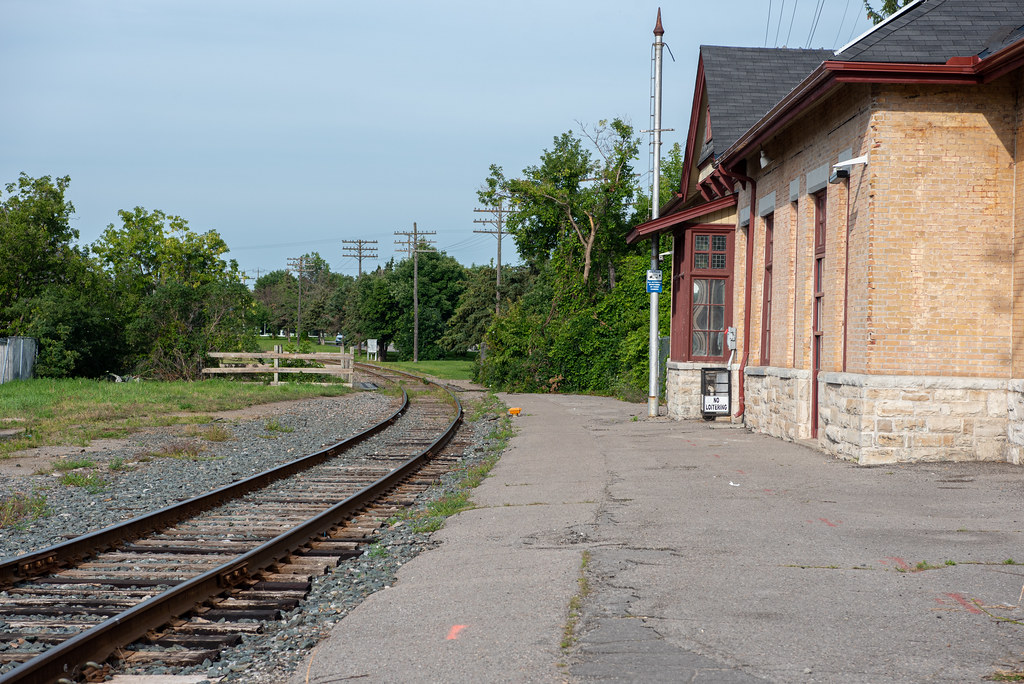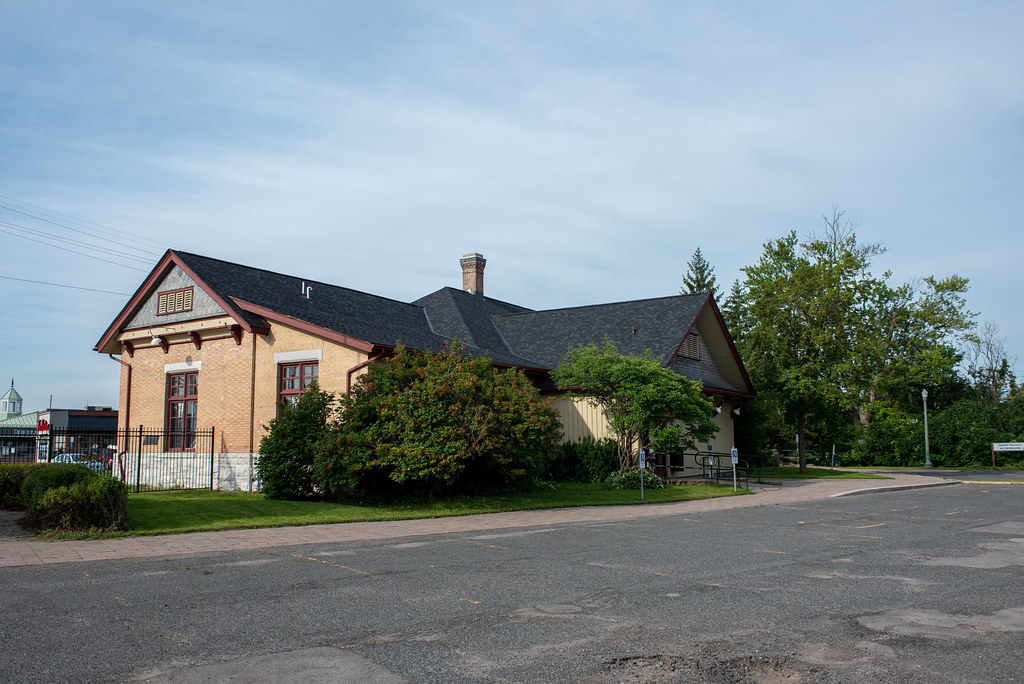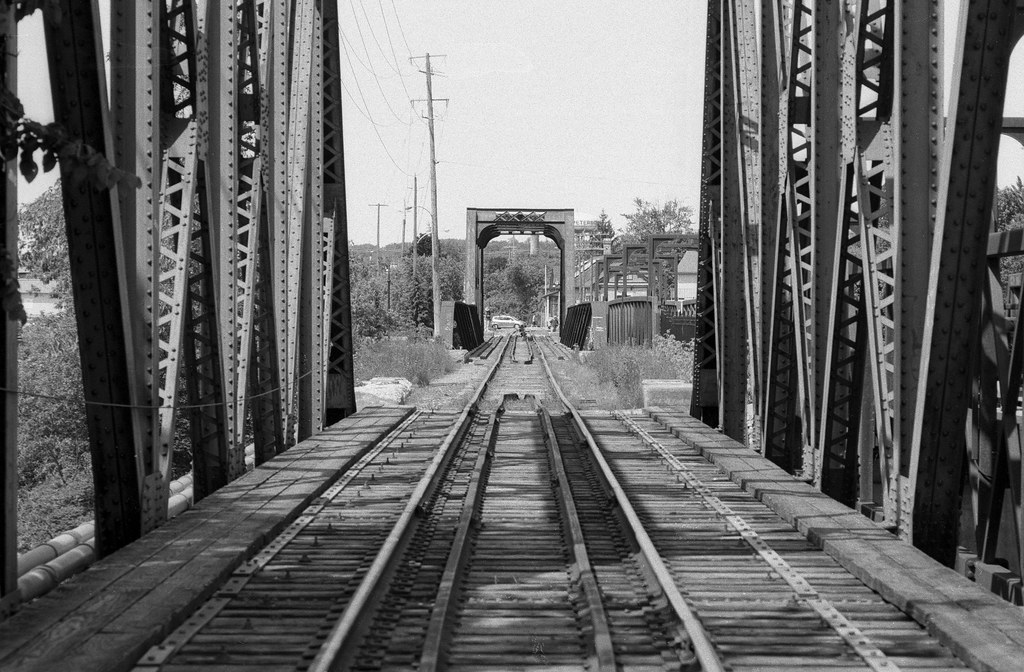The railway operator Ontario & Quebec did not last long as an independent operator, having spent much of its life under the ownership of Canadian Pacific and as a line leased to Canadian Pacific. Finding any station credited to the operator is rare, but one is sitting outside downtown Peterborough.

Graflex Crown Graphic – Fuji Fujinon-W S 1:5.6/150 – Ilford HP5+ @ ASA-200 – Pyrocat-HD (1+1+100) 9:00 @ 20C
Initially chartered in 1871, Ontario & Quebec’s plan to build a rail line between Ottawa and Toronto with stops in Carlton Place, Madoc, Peterborough, and Toronto ended up derailing in the Financial Panic of 1873. While the charter lapsed, it did not disappear entirely, and in 1881, investors in Canadian Pacific took over the charter and dumped some of their own money into the defunct operator. Canadian Pacific saw the opportunity to connect their line heading west at Callendar Station into the heart of Ontario. It also afforded them an easy way to lease existing rail lines for their purposes. While construction of the line kicked off at Perth, Ontario & Quebec absorbed the Canada Central Railway, which included the Brockville & Ottawa line, gaining a precise foothold into eastern Ontario. The new Ontario & Quebec had several new stops, including the small mining community of Havelock and other small rural settlements through central Ontario, ending up in Leaside north of Toronto. Canadian Pacific architect Thomas Charles Sorby designed a uniform station design, either a single-storey for stations located in urban centres or two-storey stations for rural affording a small apartment for the Station Agent and their family. By 1883, Ontario & Quebec gained control of Toronto, Grey & Bruce and the Credit Valley railways extended their reach to Owen Sound on the Upper Great Lakes and St. Thomas in the west. A year later, Canadian Pacific secured a 999-year lease on the entire Ontario & Quebec holdings.

Nikon D750 – AF-S Nikkor 28-70mm 1:2.8D
Nikon D750 – AF-S Nikkor 28-70mm 1:2.8D
Many railways decided to use local materials to construct their stations, but in the case of Sorby’s designs, they called for specific materials and construction techniques. The Peterborough station stood out among the other buildings that occupied the town—opting instead for a buff brick colour and red flemish bond mortar holding them together. The small single-storey station followed the Gothic Revival style popular in the day. A low roof with tuck gables, a bracketed cornice with a fish-scale detail, and a matching slate tiled roof. Square wood-framed panel windows with double-glazed glass and art class transoms gave the building a handsome appearance. Inside is a basic general waiting room with a hardwood floor and wooden bench furniture. Wainscoting and plaster walls and detailed plaster medallions in the ceiling. Attractive gas fixtures and a stove provided for excellent heat and lighting. A baggage room, agent office, ticket window and telegraph bay rounded out the station’s internals. By 1889 the station stood out as among the most handsome on the line. Twice daily trains called at Peterborough. Despite the push to standardise their stations starting in 1890 with new, more prominent Edward Maxwell-designed stations, no such station was built in Peterborough. In 1919 new inside washrooms were added, and drop ceilings were added in the 1930s to save on heat. A second expansion in the 1940s added freight and express building. The entire station receives a railroad red paint job in the 1960s with the latest rebranding of the Canadian Pacific. While long-distance passenger services were starting to dwindle, the use of Rail Desiel Cars or Dayliners became a popular caller at the Peterborough station beginning in 1953 to serve commuter traffic. When VIA rail took over in 1978, the station had fallen into disrepair. There was little VIA rail to keep the upkeep without any additional funding, and by 1990, VIA service on the line ended, and the station closed.

Nikon D750 – AF-S Nikkor 28-70mm 1:2.8D
Nikon D750 – AF-S Nikkor 28-70mm 1:2.8D
The city of Peterborough expressed an interest in purchasing the station from Canadian Pacific, which gladly offloaded the station in 1991. In a strange twist, they never asked for the station to be moved next to an active rail line. The station sat empty for several more years as restoration funding started trickling in, the first step being stripping off the mid-century paint job. The exterior architectural details were painstakingly cleaned, repaired or reproduced, including the cornice details and fish scale design. The original wooden frame windows were removed, restored and modern glass installed; the art-glass transoms were also repaired and, in some cases, replicated. Inside, much of the original details had survived and required restoration and repair work. The drop ceiling was removed, revealing the plaster medallion details stayed and needed a touch of cleaning. The restoration effort netted the station’s Federal heritage status in 1998. While the exterior retained much of its original configuration, the interior received renovation into commercial space. Today the building houses a variety of professional services. It is the oldest surviving Canadian Pacific Station and the only standing station credited to Ontario & Quebec. The rail line running next to the station remains an active part of the Havelock Subdivision, and there is a fantastic rail bridge nearby that is open to walking.

Minolta Maxxum 9 – Minolta Maxxum AF 100mm 1:2.8 Macro – Ilford FP4+ @ ASA-125 – Kodak HC-110 Dil. B 9:00 @ 20C